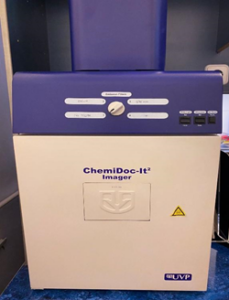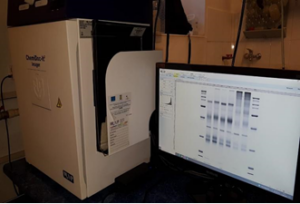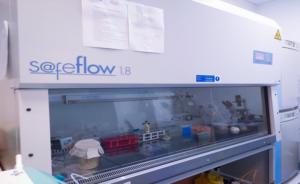
Hote cu flux laminar S@feflow 1.8 BioAir
Aceste hote cu flux laminar de siguranță microbiologică extrem de sofisticate, clasa II, tip A2, oferă cea mai înaltă siguranță pentru operator și mediu pentru manipularea agenților patogeni, culturi celulare/tisulare. Designul intern, fluxul de aer laminar și monitorizarea fluxului, dispozitivele de siguranță încorporate și gama cuprinzătoare de opțiuni unice, garantează cele mai înalte performanțe la cele mai stricte niveluri de siguranță.
Incubatoare Jouan IGO 150 Thermo Scientific
Incubatorul Thermo Scientific oferă o soluție economică pentru toate culturile de celule și țesuturi de bază, în timp ce capabilitățile personalizabile de sterilizare la temperatură înaltă oferă un plus de confort. În plus, oferă performanțe remarcabile, condiții ideale de creștere, protecție fiabilă împotriva contaminării și este ușor de operat și întreținut.
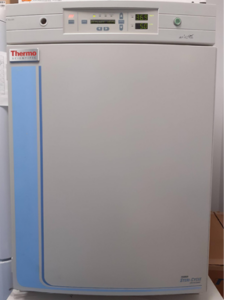
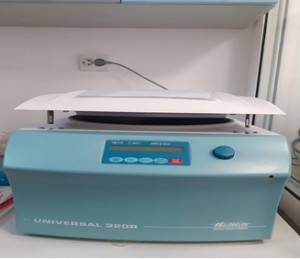
Centrifugă cu răcire Mikro 220R (Hettich)
Mikro 220 este o centrifugă puternică, compactă, pentru procesarea tuburilor cu capacitate de la 0,2 ml până la 2,0 ml. Refrigerare: răcire cu aer, Micro 220R variabil de la -20°C la +40°C.
Microscop inversat Nikon Eclipse TE300 cu camera CCD
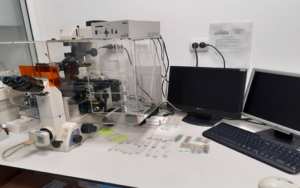
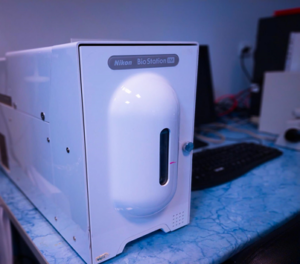
Sistem BIOSTATION IM (Nikon Corp)
Sistemul BioStation IM este un incubator de celule compact și un sistem de monitorizare care permite utilizatorilor cu experiență minimă în microscopie să obțină imagini cu celule vii. BioStation IM facilitează o gamă largă de experimente pe termen lung, inclusiv studii ale creșterii celulare, morfologiei și expresiei proteinelor, oferind un control consecvent al temperaturii, umidității și concentrației de gaz în combinație cu imagini de fază și fluorescență de o calitate excepțională.
Sistem xCELLigence (ACEA Biosciences)
Sistemul xCELLigence măsoară impedanța electrică a stratului celular, folosind un set de microelectrozi de aur topiți pe fundul godeurilor plăcilor, special proiectați pentru dispozitiv. Echipamentul poate fi plasat în interiorul unui incubator și este conectat la un laptop, pentru achiziția de date. Există 2 tipuri de plăci care pot fi utilizate cu xCELLigence RTCA DP: (1) E-Plate 16 – plăci cu 16 godeuri, utilizate pentru investigarea adeziunii, răspândirii, proliferării celulare, precum și a citotoxicității diferitelor medicamente; (2) CIM-Plate 16 – plăci cu 16 godeuri cu 2 compartimente, utilizate pentru investigarea invaziei și migrării celulelor.
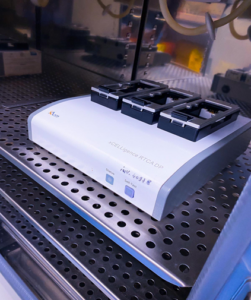
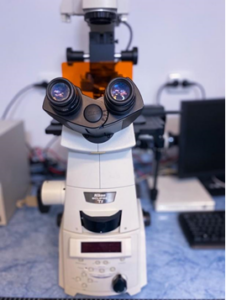
Microscop inversat cu fluorescență
(Nikon Eclipse TE300)
Microscop cu contrast de fază inversată cu cameră digitală.
Nikon TS100 Inverted Phase Contrast Microscope
Microscopul cu contrast de fază Nikon TS100 este un microscop popular cu contrast de fază inversată de înaltă calitate, utilizat de obicei pentru cultura de rutină a țesuturilor.
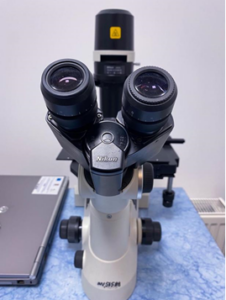
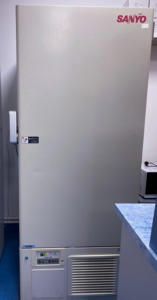
Congelator de laborator pentru temperaturi ultra joase
Congelatorul cu temperaturi ultra joase Sanyo are o capacitate de 333 litri și un interval de temperatură de la -20 la -90°C, controlat de un sistem cu microprocesor pentru un control precis al temperaturii.
QX200 Droplet Digital PCR System (Bio Rad)
Instrumentul permite cuantificarea ADN-ului (numărul de copii) în absența curbei standard. Cuantificarea ADN-ului se bazează pe PCR cu fluorescentă, cu SYBRgreen sau TaqMan. Sistemul este foarte util pentru: (1) detectarea mutațiilor rare; (2) pentru dozarea numărului de copii atunci când diferențele dintre nivelul de expresie țintă dintre probe sunt reduse (în general, astfel de diferențe discrete nu au putut fi determinate prin qPCR standard). Principala caracteristică a sistemului este că amestecul PCR este împărțit în aproximativ 20000 de picături, iar fiecare picătură este echivalentul unei reacții de PCR.
- A) QX200 Cititor de picături (stânga), C1000 ciclator termic (dreapta)
- B) PX1 Sigilatorul de plăci (stânga), QX100 Generator de picături (dreapta)
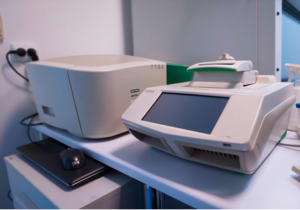
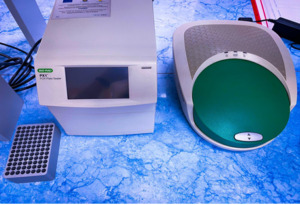
QuantStudio 7 Flex – sistem qPCR cu blocuri pentru plăci rapide PCR 96 și pentru carduri PCR array
Cuantificarea ADN-ului se bazează pe PCR fluorescentă, cu SYBRgreen sau TaqMan. Instrumentul are două blocuri interschimbabile pentru cardul microfluidic cu 384 de godeuri (cardul matrice, nu plăci cu 384 de godeuri) și plăcile Fast cu 96 de godeuri (volumul godeului este de 0,1 ml). Pentru mai multe detalii tehnice, vă rugăm să urmați linkul: https://www.thermofisher.com/order/catalog/product/4485700
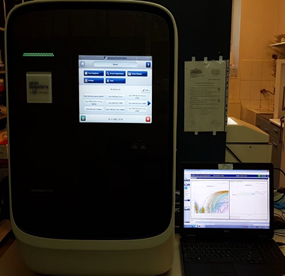
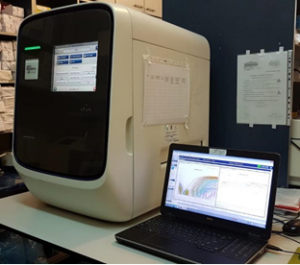
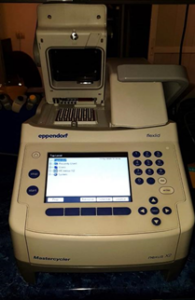
Eppendorf Mastercycler NEXUS PCR Thermal Cycler
Mastercycler® Nexus X2 are un software modern și intuitiv. Prezinta două blocuri. Unul dintre blocuri cu 32 de godeuri este potrivit pentru teste mici, în timp ce testele mai mari pot fi efectuate pe blocul cu 64 de godeuri.
Aplicații: PCR standard, genotipare, detectarea mutațiilor.
Nikon SMZ1500 Sistem (lupă binocular)
Prezinta un raport de zoom 15:1, care oferă un interval de mărire de la 0,75x la 11,25x. Acest lucru permite imagistica precisă a unei game largi de specimene, de la celule mici până la mostre de țesut mari. Iluminare de sus și de jos.
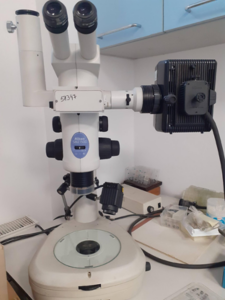
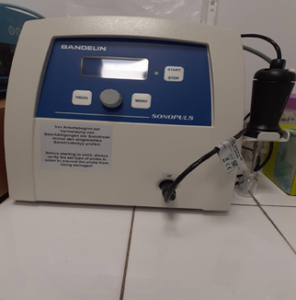
Sonicator Bandelin Sonopuls Mini20
Dispozitiv folosit pentru emulsionare, omogenizare, suspendare, distrugere celulară, degazare, accelerare a reacțiilor, sonochimie. Gata de operare pentru volume de la 0,5 ml la 0,25 ml.
Mini-PROTEAN Tetra Cell si Mini Trans-Blot Module
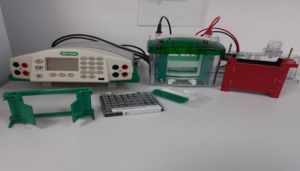
Chemidoc-It2 515 Imager, pentru captarea/cuantificarea imaginilor chemiluminescente/fluorescente/blot/gel
Aplicațiile pentru acest sistem includ bloturi chemiluminiscente, Northern blot, Southern blot, Western blot, western fluorescente, protein blots, dot blots, geluri proteice, bioluminiscență, geluri ADN, geluri cu lumină albastră, geluri TLC, plăci de colonie, geluri 2D, multiplex, colorimetrice, geluri cu lumină vizibilă, autoradiografii, microplăci, micromatrice. Sistemul are mai multe filtre pentru un panou mare de coloranți: 595/30 (Alexa Fluor 555, AF 546, Cy3, DyLight550), 645/38 (Alexa Fluor 568, AF 594, Texas Red, Red Fluorescent Protein), 695/33 (Alexa Fluor 633, AF 647, Cy5, Cy5.5, Multifluor Red), 535/22 (Alexa Fluor 488, FITC, FAM, SYBRgreen, proteină fluorescentă galbenă, albastru multifluor).
Pentru mai multe detalii tehnice, vă rugăm să urmați linkul:
http://www.uvp.com/chemidocit2.html
